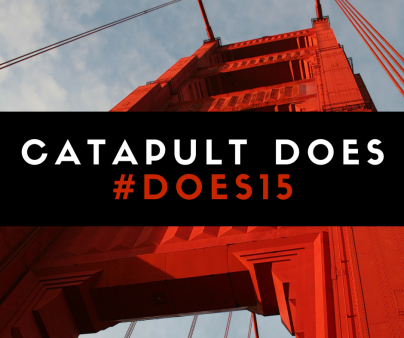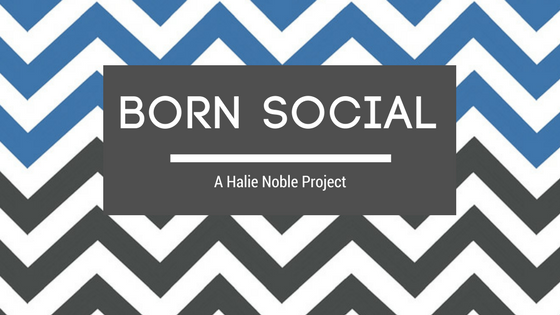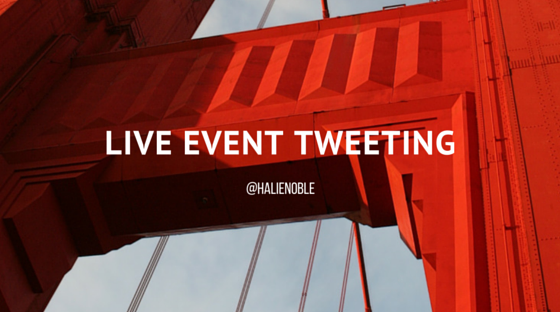
Prepare images ahead of time if you have certain messages you know you want to convey throughout an event. I created this image for my agency’s blog post on its involvment in the conference.
Studying the results of last year’s efforts and what I have learned since, I came up with five basic considerations to always keep in mind when sharing for/from/about an industry event similar to DOES.
- What topics and ideas is your audience most interested in?
First and foremost, you want to share what people care about. Share tweetable tidbits from conference sessions, behind the scenes photos and secrets, trends you notice and other personal observations that provide your audience access/visibility to the event in some way they wouldn’t have without your help.Don’t tweet: “So-and-so is taking the stage to discuss [insert session title from conference pamphlet]”
Tweet: “Loved @SoandSo’s take on______ ! “[insert quote from speaker]”Dont tweet: “There is a post-conference happy hour happening in the main lobby now.”
Tweet: “Any hour w/the awesome folks at [insert event hashtag] is a happy hour. Come say hi to me in the main lobby now!”Don’t tweet: “The main stage is set up and ready to host the brilliant minds at [insert event name].”
Tweet: Can’t wait to hear all the geniuses that will take the [insert event hashtag]’s awesome main stage” + an actual photo you took of the stage. - What topics and ideas are your client/boss most interested in promoting?Maybe you are just at an event for yourself, or because your company sent you to learn and absorb what you desire to.
More likely, there is some sort of objective. Whether you are tweeting on behalf of an event (as I do), on behalf of someone else (a thought leadership strategy), or as a representative of a company present at an event (think sponsors), you must strongly consider what is it that those paying for you to be at an event care most about publicizing.At DOES there are several breakout sessions every day, that means four or more amazing sessions compete against each other at the same time, multiple times a day. While there may be topics you’re personally drawn to and want to cover, you must keep in mind what topics are most relevant your objective.Is anyone from the organization you are representing speaking at the event? – You gotta be there.Are any of your client’s customers/partners present at the event? – You should be talking about that.
What statements being made directly relate to the fields your client is involved in?
– Have a reaction that is inline with organizational messaging and objectives. - Is what you are about to share a coherent thought, understandable to someone not in the room?
One of the most valuable aspects of sharing live updates and content via social media at an in-person event is that participants no longer have to be “in person.” To see what is going on at an event and involve themselves in happening conversations, all users need to do is log into twitter, facebook, instagram etc.
But remember, that is all they are doing. They do not have the same visibility as you and they likely don’t have access into the information being shared that doesn’t make it to their social feed. If you are trying to drive involvement, don’t share content that is illogical from an outsider’s perspective.Include as much context as possible and try to ensure that what you’re sharing is a complete thought and could stand on it’s ownDont tweet: “Holy crap what a great session.”
Tweet: “Holy crap, the entire [insert event hashtag] crowd just lost it when @[insert speaker handle/name] shared their results: [insert useful soundbite, shared stats, ect.]” - Are You Fast and Focused?
When sharing content live, there is always a rush. You are moving fast trying to listen, type and read at the same time. This is when serious mistakes get made. If you are halfway through writing a tweet and you can’t remember with certainty what was said, don’t tweet it – certainly don’t attribute it to anyone who may resent being misquoted.You have to focus on what was said while listening to what is being said. If a speaker starts a phrase like “The one thing you must consider when…” and then ends up on a tangent, never completing the thought, never complete the tweet.People are very aware of their social media profiles and presence, if you misquote someone badly enough to change their meaning you risk being called out on social media yourself – something one only enjoys in a positive light.
- How can you drive the most engagement from your micro content?
Just because you are moving fast, doesn’t mean you have to move dumb. As always, you want to drive your content to as many relevant people as well. As with regular social sharing, this is greatly aided by the use of proper hashtags and handles.More often than not these days, conferences will have an official hashtag and publicize that at least somewhere in a program – if not more flagrantly. USE IT. Sending a tweet from a conference without its official hashtag sends the tweet to your followers, not those specifically interested in following the event.Also, if a speaker is worth his weight in stage time, they will have a social media presence and twitter handle. Find those ahead of time. Often an event’s program may include speaker handles, however this is not always the case. Come prepared with handles and hashtags identified and ready for use.


One thought on “How To Live Tweet at an Industry Conference – Five Key Considerations”